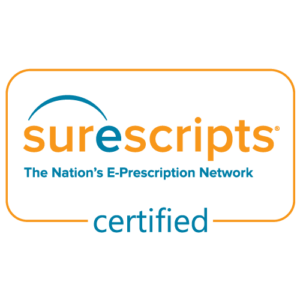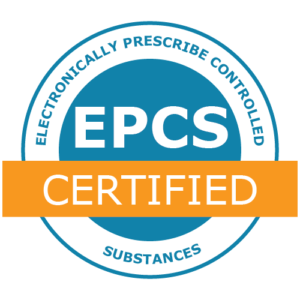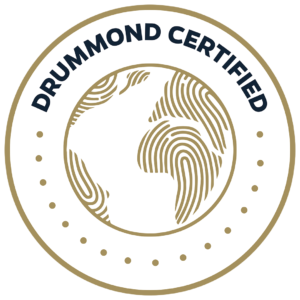Key Features of Electronic Prescribing of Controlled Substances (EPCS)
EPCS Certified
DocVilla is EPCS DEA certified which means you can Electronically Prescribe Controlled Substances. DocVilla offers a seamless workflow which reduces any chances of error.
Hard/Soft tokens
If you enroll in EPCS with DocVilla then DocVilla provides you with both hardware and software tokens for two-factor authentication as is mandated by DEA.
Seamless Workflow
DocVilla offers seamless workflow with safeguards in place to the providers which increases productivity, reduces chances of error. You can add EPCS to your account for a small fee.



How Does EPCS Work?
The DEA requires a 2-Factor Authentication sign off, meaning when a prescriber electronically sends a controlled substance prescription they must sign it using a password and a token. Each prescriber who wishes to e-Prescribe controlled substances must go through an identity proofing and authentication process in order to receive a token. DocVilla EMR supports two factor authentication for HIPAA compliance. You will need a password to login and then will have to enter a one-time code sent to you email. Then in order to electronically prescribe controlled substances, you will have to enter auto generated number from your soft or hard token. This ensures the system is secure and safe!
What is EPCS (Electronic Prescription of Controlled Substances), Benefits, and Overview of Regulatory Requirements?
Did you know that the studies done by the CDC have revealed that in the year 2018, drug overdoses resulted in more than 70,000 deaths and of those, about two-thirds involved opioids or prescription drugs? The controlled substances were misused mainly because of the paper prescriptions and the theft of the Prescriber’s DEA number and its fraudulent use. As per the federal law, any prescription for the controlled substances was required to be issued in writing. However, the US Drug Enforcement Administration or DEA amended its regulations in June 2010. In order to reduce needless deaths, the DEA provided clinical practitioners with the option of issuing Electronic Prescriptions for Controlled Substances or EPCS to a pharmacy in lieu of a paper prescription. Any drug that has the potential for abuse or dependence is a controlled substance and is categorized in five Schedules. The potential of their abuse decreases as we move from Schedule 1 to 5. Even though the electronic prescribing for Schedule 2 through 5 controlled substances was legalized in the United States in the year 2010, many states did not allow Schedule 2 drugs to be e-prescribed then. But now, all drug schedules except Schedule 1 are legally allowed to be e-prescribed in all the 50 States. Moreover, more than 99% of the U.S. pharmacies are EPCS enabled thus allowing widespread adoption. The DEA legalized the use of EPCS as a technology solution for 2 main reasons. The first was to deter the rising prescription drug abuse. The second was to address the issue of fraudulent and stolen prescriptions by requiring prescriber authentication. It allowed the clinical practitioners to write and transmit controlled substance prescriptions electronically without exposing their DEA number and also permitted the pharmacies to receive it safely. DEA Rules require that a provider should first register with the DEA after which they would receive a DEA number to prescribe controlled substances. The provider is also required to maintain two-factor authentication tokens and passwords. The practitioner’s responsibilities are the same when prescribing electronically as they are with oral or paper prescriptions. DEA rules require the EMR technology to be a certified product. It ensures proper account creation, signing, and refilling of controlled substance prescriptions. The technology must allow prescribers to access identity verification as well as two-factor authentication. E-prescribing is now part of the “Every Prescription Conveyed Securely”, a mandate by the federal government which will take effect in 2021. Electronic prescribing with built-in features is one of the most effective ways to prevent drug abuse. DocVilla is EPCS certified and offers end to end solution for meeting DEA requirements for EPCS. DocVilla supports DEA approved two-factor authentication and provides e-prescribing workflows which providers love.
Learn More about Electronic Prescribing of Controlled Substances (EPCS)
DocVilla is EPCS eRx certified which means that providers on DocVilla platform can prescribe controlled substances to their patients. As e-Prescribing is becoming the norm, the need for electronic prescribing of controlled substances Schedule II-V drugs is becoming greater. The Federal DEA (Drug Enforcement Agency) requires that EPCS certified EMRs and Software to meet the strict requirements and go through a third-party audit to check that these requirements are met. DocVilla has been audited by Better Partners LLC and certified by Surescripts® and exceeds those requirements. We are one of the few EMRs platforms which have this certification.
EPCS is allowed in all the 50 states. However, the law does not allow providers to prescribe EPCS through telemedicine. However, if you have in-person office setting then you can electronically prescribe controlled substances.
EHR with integrated Electronic Prescribing of Controlled Substances (EPCS)
In today’s rapidly evolving healthcare environment, technology plays a critical role in streamlining workflows and enhancing patient safety. Electronic Prescribing of Controlled Substances (EPCS) has emerged as a vital tool in modern healthcare practices, offering a secure and efficient method for managing prescriptions of controlled substances. DocVilla integrates EPCS within its Electronic Health Record (EHR) system, providing healthcare providers with a comprehensive solution to enhance prescribing practices, improve patient outcomes, and ensure compliance with regulatory standards.
Understanding Electronic Prescribing of Controlled Substances (EPCS)
EPCS Defined: Electronic Prescribing of Controlled Substances (EPCS) refers to the use of electronic systems to transmit prescriptions for controlled substances from healthcare providers to pharmacies. EPCS aims to enhance the security and accuracy of controlled substance prescriptions, reducing the risk of errors, misuse, and fraud associated with paper prescriptions.
Key Benefits of EPCS:
Enhanced Patient Safety: EPCS reduces the risk of prescription errors and enhances patient safety by ensuring that prescriptions are transmitted accurately and securely.
Improved Workflow Efficiency: By integrating EPCS within an EHR system, healthcare providers can streamline the prescribing process, reducing administrative burdens and allowing more time for patient care.
Compliance and Security: EPCS ensures compliance with regulatory standards, providing a secure platform for managing controlled substance prescriptions and reducing the risk of diversion and fraud.
The Role of EPCS in Modern Healthcare
Electronic Prescribing of Controlled Substances plays a crucial role in transforming prescribing practices, offering healthcare providers a secure and efficient method for managing controlled substance prescriptions.
Enhancing Patient Safety and Care
Patient safety is a top priority in healthcare, and Electronic Prescribing of Controlled Substances contributes to safer prescribing practices by reducing the risk of errors and enhancing the accuracy of prescriptions.
Key Ways EPCS Enhances Patient Safety:
Accurate Prescription Transmission: Electronic Prescribing of Controlled Substances eliminates the risk of errors associated with handwritten prescriptions, ensuring that prescriptions are transmitted accurately to the pharmacy.
Real-Time Access to Patient Information: By integrating EPCS with an EHR system, healthcare providers have real-time access to patient information, enabling informed prescribing decisions and reducing the risk of adverse drug interactions.
Reduced Risk of Prescription Fraud: EPCS reduces the risk of prescription fraud and misuse by providing a secure platform for transmitting prescriptions, ensuring that only authorized providers can prescribe controlled substances.
Streamlining Workflow Efficiency
EPCS streamlines the prescribing process, reducing administrative burdens and enhancing workflow efficiency for healthcare providers.
Key Ways EPCS Enhances Workflow Efficiency:
Integrated EHR System: By integrating EPCS within an EHR system, healthcare providers can manage prescriptions alongside patient records, streamlining workflows and reducing the need for duplicate data entry.
Automated Refill Requests: Electronic Prescribing of Controlled Substances allows for automated refill requests, reducing the time and effort required to manage prescription refills and enhancing patient satisfaction.
Improved Communication with Pharmacies: EPCS enables direct communication between healthcare providers and pharmacies, reducing the need for follow-up calls and faxes and ensuring timely prescription fulfillment.
Ensuring Compliance and Security
Compliance with regulatory standards is essential in healthcare, and EPCS provides a secure platform for managing controlled substance prescriptions, ensuring compliance with legal and ethical standards.
Key Ways EPCS Ensures Compliance and Security:
Two-Factor Authentication: EPCS systems typically require two-factor authentication, ensuring that only authorized providers can prescribe controlled substances and reducing the risk of unauthorized access.
Audit Trails and Reporting: EPCS systems provide audit trails and reporting capabilities, allowing healthcare providers to track prescribing patterns and ensure compliance with regulatory standards.
Integration with PDMPs: EPCS systems can be integrated with Prescription Drug Monitoring Programs (PDMPs), providing healthcare providers with real-time access to controlled substance records and enhancing patient safety.
Integrating EPCS within DocVilla’s EHR System
DocVilla’s cloud based EHR and practice management system seamlessly integrates EPCS, providing healthcare providers with a comprehensive solution to enhance prescribing practices and streamline workflows.
Key Features of DocVilla’s EPCS Integration
DocVilla’s EPCS integration offers a range of features designed to enhance prescribing practices, improve patient safety, and ensure compliance with regulatory standards.
Seamless Workflow Integration:
Integrated EHR Platform: DocVilla’s EPCS integration allows healthcare providers to manage prescriptions alongside patient records within a single platform, streamlining workflows and reducing administrative burdens.
Automated Prescription Management: DocVilla’s EPCS integration automates prescription management, allowing for easy tracking of prescription status and refill requests, reducing the time and effort required for prescription management.
Enhanced Patient Safety:
Real-Time Patient Information: By integrating EPCS with DocVilla’s EHR system, healthcare providers have real-time access to patient information, enabling informed prescribing decisions and reducing the risk of adverse drug interactions.
Secure Prescription Transmission: DocVilla’s EPCS integration ensures secure transmission of prescriptions, reducing the risk of prescription errors and enhancing patient safety.
Compliance and Security:
Two-Factor Authentication: DocVilla’s EPCS integration requires two-factor authentication, ensuring that only authorized providers can prescribe controlled substances and reducing the risk of unauthorized access.
Audit Trails and Reporting: DocVilla’s EPCS integration provides audit trails and reporting capabilities, allowing healthcare providers to track prescribing patterns and ensure compliance with regulatory standards.
Integrating EPCS with PDMPs
DocVilla’s EPCS integration can be seamlessly integrated with Prescription Drug Monitoring Programs (PDMPs), providing healthcare providers with real-time access to controlled substance records and enhancing patient safety.
Electronic Prescribing of Controlled Substances is allowed in all the 50 states. However, each state law is different and many of them do not allow providers to prescribe EPCS through telemedicine. However, if you have in-person office setting then you can electronically prescribe controlled substances.

Benefits of Integrating EPCS with PDMPs:
Access to Comprehensive Prescription Records: PDMPs provide healthcare providers with access to comprehensive prescription records, allowing for informed prescribing decisions and reducing the risk of prescription drug misuse.
Enhanced Patient Safety: By integrating EPCS with PDMPs, healthcare providers can identify patients at risk of prescription drug misuse or abuse, allowing for early intervention and enhanced patient safety.
Compliance with Regulatory Standards: Integration with PDMPs ensures compliance with regulatory standards, providing healthcare providers with a secure platform for managing controlled substance prescriptions.

Leveraging EPCS for Improved Patient Outcomes
Electronic Prescribing of Controlled Substances offers healthcare providers a range of benefits that contribute to improved patient outcomes, enhanced workflow efficiency, and compliance with regulatory standards.
By leveraging EPCS, healthcare providers can enhance patient engagement and satisfaction by providing a secure and efficient method for managing prescriptions.
Key Benefits of EPCS for Patient Engagement:
Convenient Prescription Management: Electronic Prescribing of Controlled Substances allows patients to receive prescriptions electronically, reducing the need for paper prescriptions and enhancing convenience.
Timely Prescription Fulfillment: EPCS ensures timely prescription fulfillment, reducing wait times at the pharmacy and enhancing patient satisfaction.
Improved Communication: EPCS enables direct communication between healthcare providers and pharmacies, reducing the need for follow-up calls and enhancing the patient experience.
Improving Operational Efficiency
Electronic Prescribing of Controlled Substances streamlines the prescribing process, reducing administrative burdens and enhancing workflow efficiency for healthcare providers.
Key Benefits of EPCS for Operational Efficiency:
Reduced Administrative Burden: By automating prescription management, Electronic Prescribing of Controlled Substances reduces the administrative burden on healthcare providers, allowing them to focus on providing quality care.
Streamlined Workflow: Electronic Prescribing of Controlled Substances streamlines the prescribing process, reducing the time and effort required for prescription management and enhancing workflow efficiency.
Enhanced Resource Utilization: By improving workflow efficiency, Electronic Prescribing of Controlled Substances allows healthcare providers to optimize resource utilization, reducing costs and enhancing practice performance.
Ensuring Compliance and Security
Electronic Prescribing of Controlled Substances provides a secure platform for managing controlled substance prescriptions, ensuring compliance with regulatory standards and reducing the risk of diversion and fraud.
Key Benefits of EPCS for Compliance and Security:
Secure Prescription Transmission: Electronic Prescribing of Controlled Substances ensures secure transmission of prescriptions, reducing the risk of prescription errors and enhancing patient safety.
Compliance with Regulatory Standards: Electronic Prescribing of Controlled Substances ensures compliance with regulatory standards, providing healthcare providers with a secure platform for managing controlled substance prescriptions.
Enhanced Audit Trails: EPCS provides audit trails and reporting capabilities, allowing healthcare providers to track prescribing patterns and ensure compliance with regulatory standards.
Implementing Electronic Prescribing of Controlled Substances in your practice with DocVilla is a straightforward process that offers a range of benefits for healthcare providers and patients alike.
Benefits of Using EPCS with DocVilla EHR
By implementing EPCS with DocVilla, healthcare providers can enhance their prescribing practices, improve patient outcomes, and ensure compliance with regulatory standards.
Key Benefits of Implementing EPCS with DocVilla:
Enhanced Patient Safety: DocVilla’s EPCS integration enhances patient safety by reducing the risk of prescription errors and ensuring secure transmission of prescriptions.
Improved Workflow Efficiency: By integrating EPCS with DocVilla’s EHR system, healthcare providers can streamline workflows and reduce administrative burdens, allowing more time for patient care.
Compliance and Security: DocVilla’s EPCS integration ensures compliance with regulatory standards, providing a secure platform for managing controlled substance prescriptions and reducing the risk of diversion and fraud.
Electronic Prescribing of Controlled Substances (EPCS) is a transformative tool that enhances prescribing practices, improves patient outcomes, and ensures compliance with regulatory standards. By integrating EPCS with DocVilla’s EHR system, healthcare providers can leverage advanced technology to streamline workflows, enhance patient safety, and improve operational efficiency.


